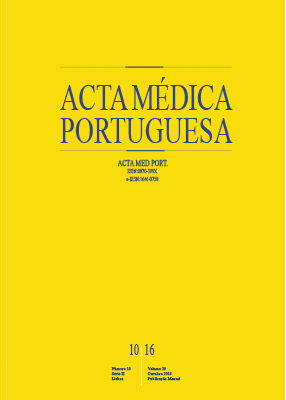Uterine Carcinosarcoma: Clinicopathological Features and Prognostic Factors
DOI:
https://doi.org/10.20344/amp.7078Keywords:
Carcinosarcoma, Neoplasm Staging, Prognosis, Survival Rate, Uterine Neoplasms.Abstract
Introduction: Uterine carcinosarcoma is a rare and aggressive biphasic malignancy and is currently included in the high risk endometrial carcinoma group. The aims of this study were to determine the clinicopathological profile, treatment, recurrence/progression patterns, survival and prognostic factors.
Material and Methods: Retrospective study of 42 patients, surgically staged and followed-up at a cancer centre, between 2005 and 2013. Clinical data was retrieved from records and pathological characteristics were reviewed for this study.
Results: Median age was 72 years (61 - 78) and the majority presented comorbid diseases. Stage distribution as follows: 13 (31.0%) stage I; eight (19.0%) stage II; nine (21.4%) stage III; and 12 (28.6%) stage IV. Chemotherapy was instituted in 12 patients and 21 received radiotherapy. Disease progressed in 16 patients and recurred in nine after a short interval. Median overall survival was 18 months (6.8 - 40) and median disease-free survival was 6 months (0 – 22.8). The only independent prognostic factor related with poor survival was serosal invasion (p = 0.02; HR adjusted 4.22; IC 95% 1.29 – 13.79).
Discussion: In accordance to other studies, diagnosis of uterine carcinosarcoma is frequently done with advanced disease and presents a high rate of progression/recurrence. The variable which has been consistently identified as main prognostic factor is stage, but in this study the only independent factor was serosal invasion.
Conclusion: The present study represents the larger series of uterine carcinosarcoma studied in Portugal and reflects the clinical presentation, histopathological characteristics and stage at diagnosis and confirms the aggressiveness of this rare tumor.
Downloads
Downloads
Published
How to Cite
Issue
Section
License
All the articles published in the AMP are open access and comply with the requirements of funding agencies or academic institutions. The AMP is governed by the terms of the Creative Commons ‘Attribution – Non-Commercial Use - (CC-BY-NC)’ license, regarding the use by third parties.
It is the author’s responsibility to obtain approval for the reproduction of figures, tables, etc. from other publications.
Upon acceptance of an article for publication, the authors will be asked to complete the ICMJE “Copyright Liability and Copyright Sharing Statement “(http://www.actamedicaportuguesa.com/info/AMP-NormasPublicacao.pdf) and the “Declaration of Potential Conflicts of Interest” (http:// www.icmje.org/conflicts-of-interest). An e-mail will be sent to the corresponding author to acknowledge receipt of the manuscript.
After publication, the authors are authorised to make their articles available in repositories of their institutions of origin, as long as they always mention where they were published and according to the Creative Commons license.









